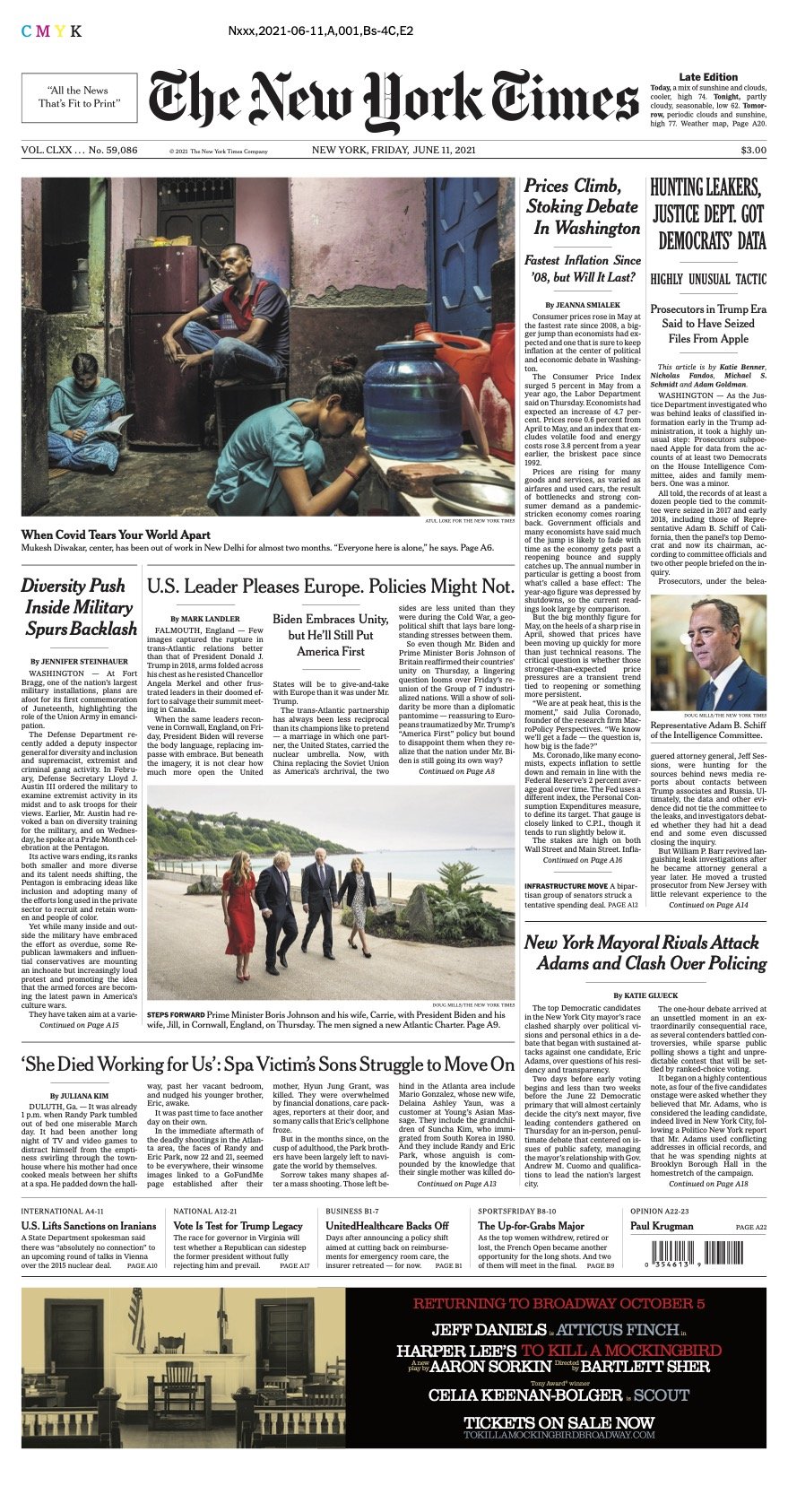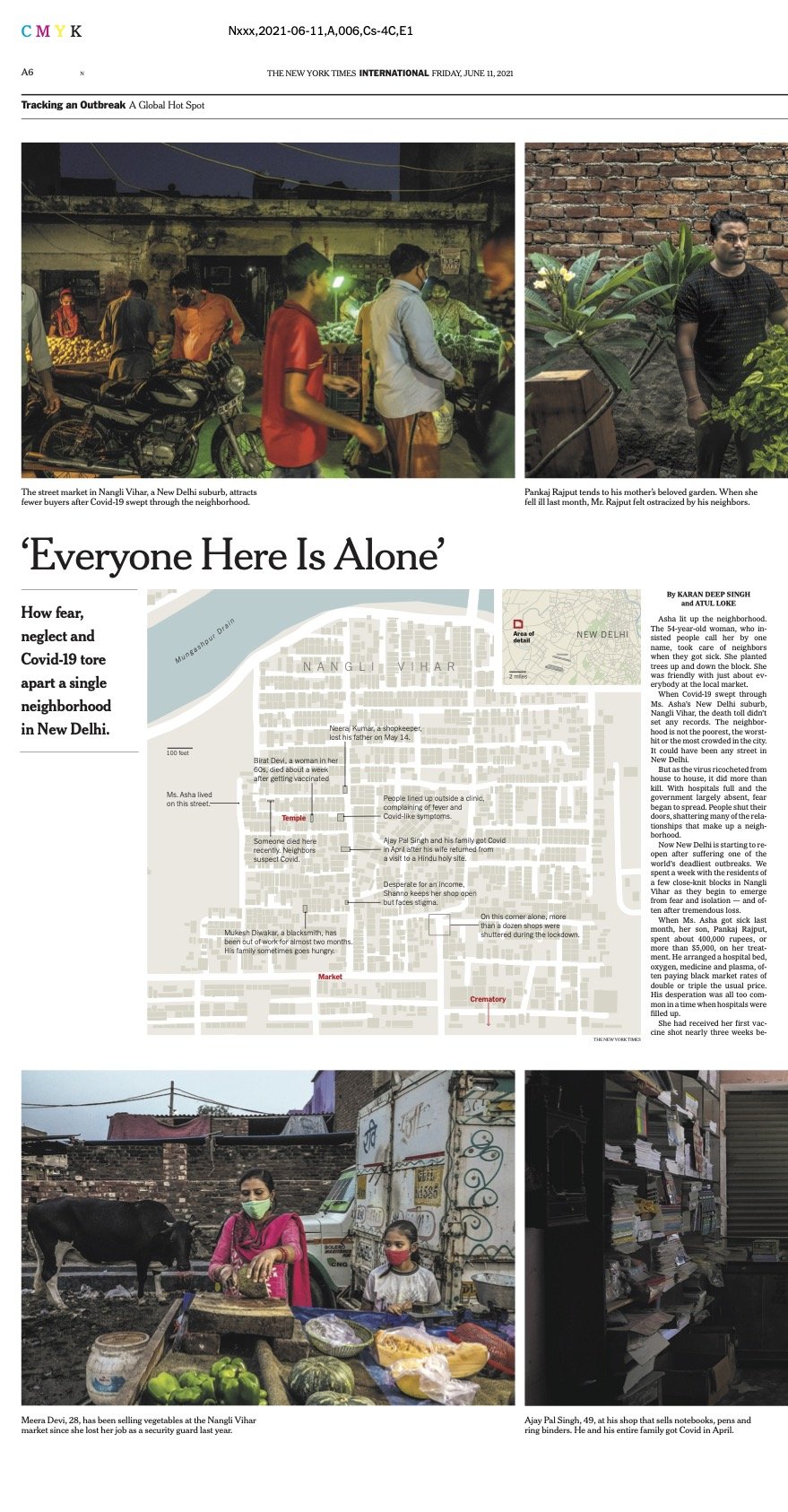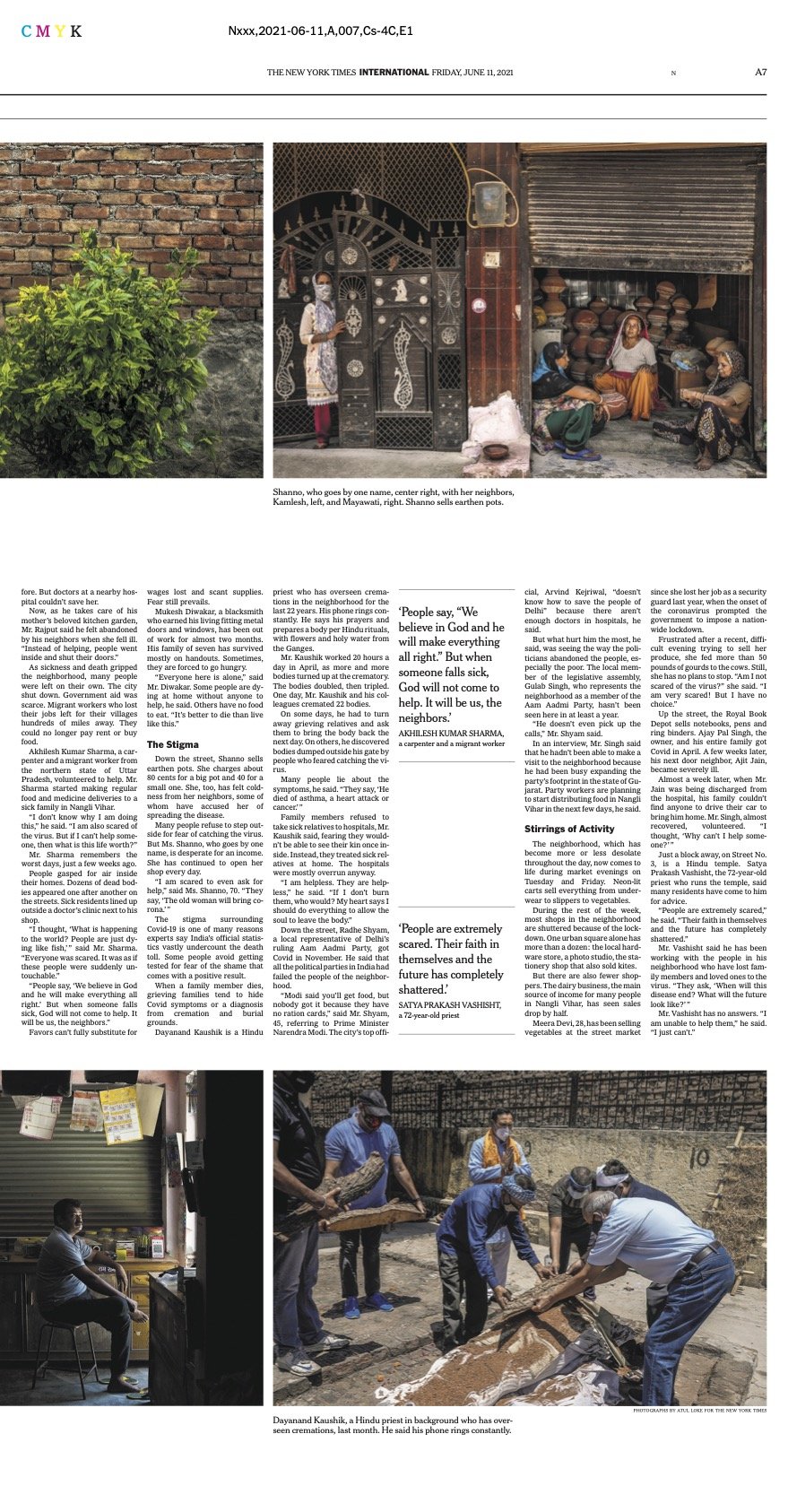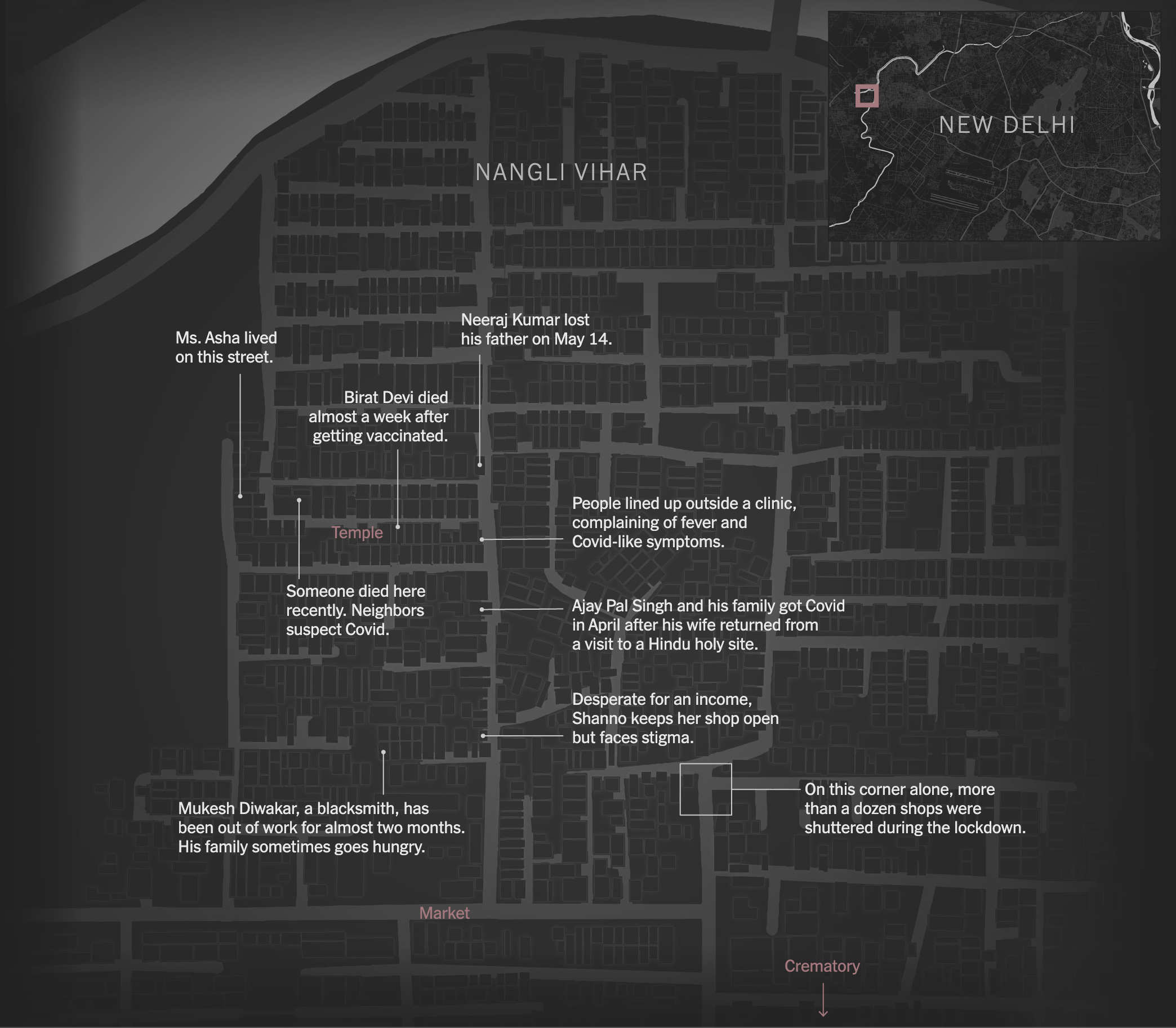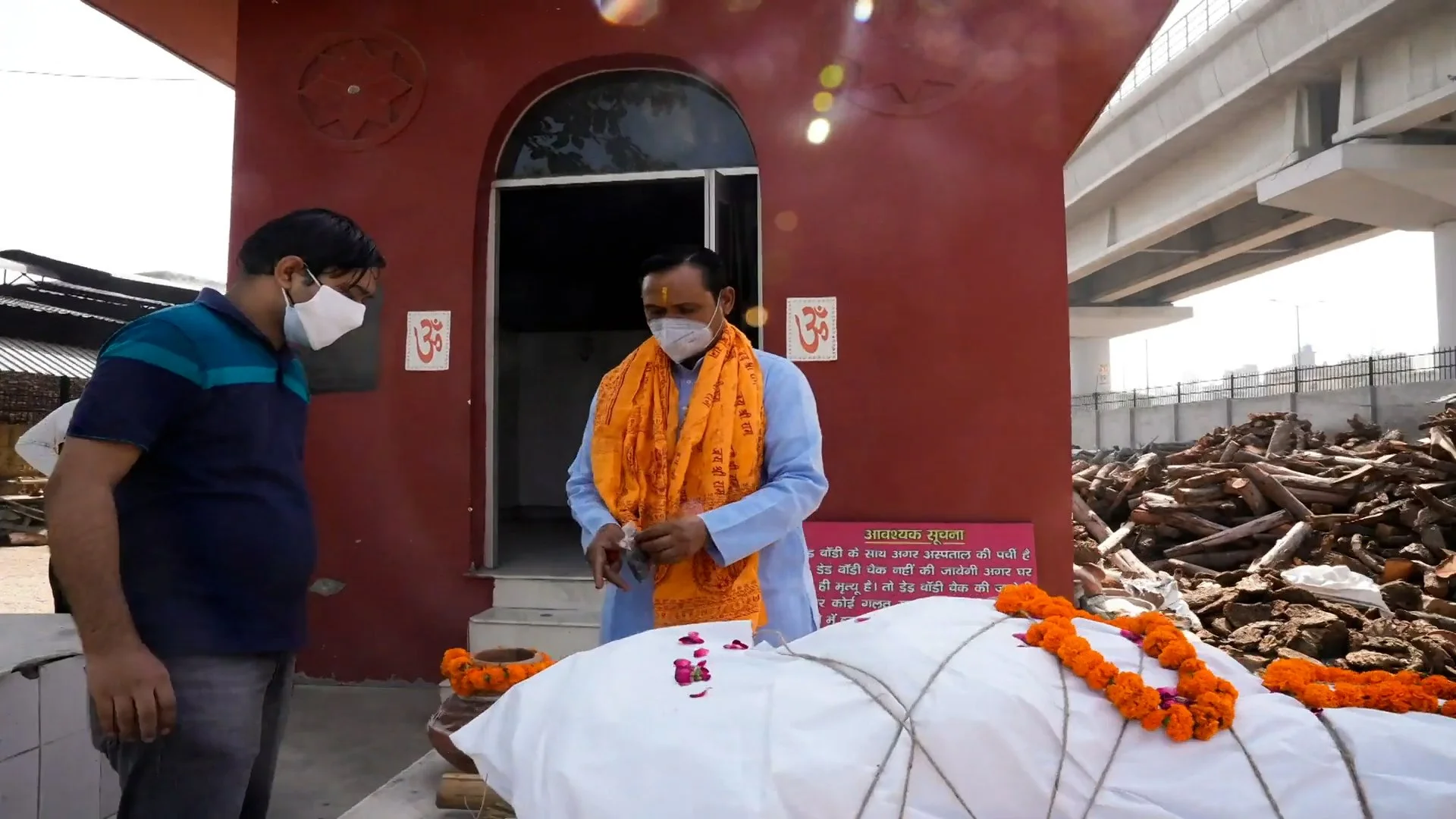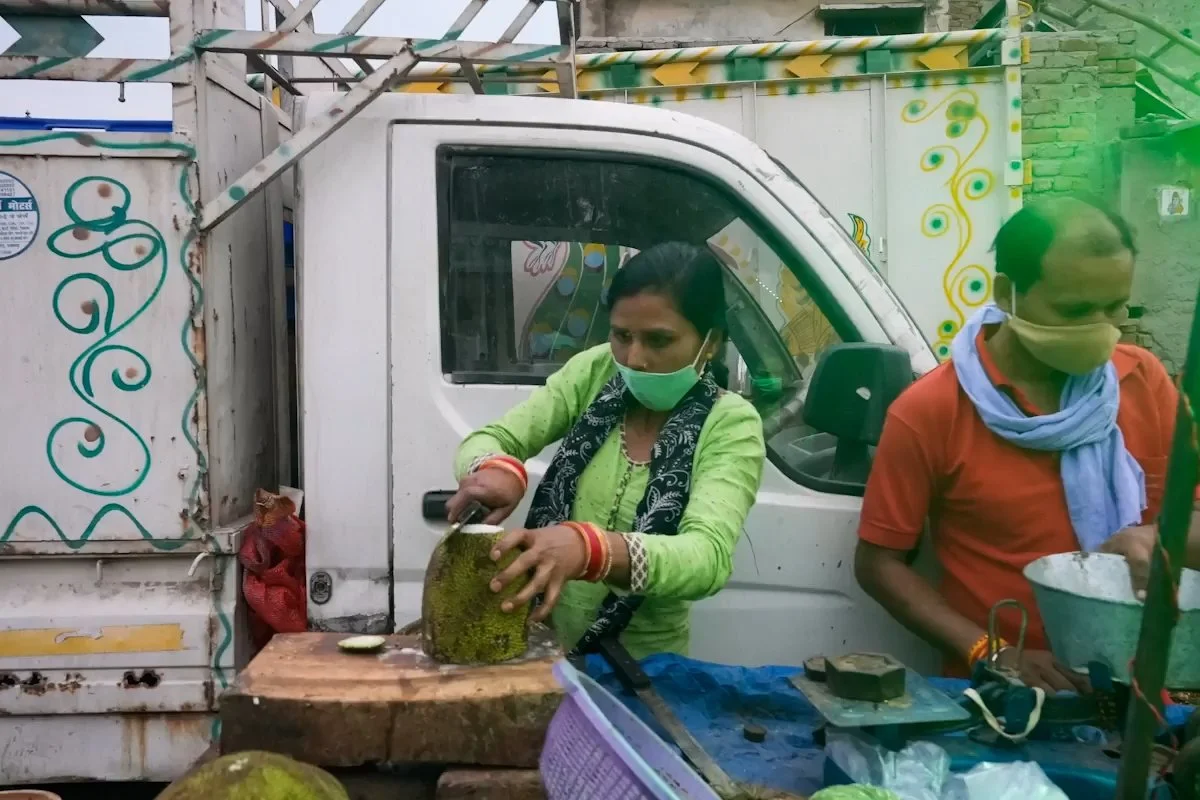‘Everyone here is alone’
THE NEW YORK TIMES, JUNE 4, 2021
How fear, neglect and Covid-19 tore apart a single New Delhi neighborhood.
BY KARAN DEEP SINGH AND ATUL LOKE
Asha lit up the neighborhood. The 54-year-old woman, who insisted people call her by one name, took care of neighbors when they got sick. She planted trees up and down the block. She was friendly with just about everybody at the local market.
When Covid-19 swept through Ms. Asha’s New Delhi suburb, Nangli Vihar, the death toll didn’t set any records. The neighborhood is not the poorest, the worst-hit or the most crowded in the city. It could have been any street in New Delhi.
But as the virus ricocheted from house to house, it did more than kill. With hospitals full and the government largely absent, fear began to spread. People shut their doors, shattering many of the relationships that make up a neighborhood.
Now New Delhi is starting to reopen after suffering one of the world’s deadliest outbreaks. We spent a week with the residents of a few close-knit blocks in Nangli Vihar as they begin to emerge from fear and isolation — and often after tremendous loss.
A map of the neighborhood of Nangli Vihar.
When Ms. Asha got sick last month, her son, Pankaj Rajput, spent about 400,000 rupees, or more than $5,000, on her treatment. He arranged a hospital bed, oxygen, medicine and plasma, often paying black market rates of double or triple the usual price. His desperation was all too common in a time when hospitals were filled up.
Pankaj Rajput and his mother in November. Photo: Courtesy Pankaj Rajput
She had received her first vaccine shot nearly three weeks before. But doctors at a nearby hospital couldn’t save her.
Now, as he takes care of his mother’s beloved kitchen garden, Mr. Rajput said he felt abandoned by his neighbors when she fell ill. “Instead of helping, people went inside and shut their doors.”
As sickness and death gripped the neighborhood, many people were left on their own. The city shut down. Government aid was scarce. Migrant workers who lost their jobs left for their villages hundreds of miles away. They could no longer pay rent or buy food.
Akhilesh Kumar Sharma, a carpenter and a migrant worker from the northern state of Uttar Pradesh, volunteered to help.
Mr. Sharma started making regular food and medicine deliveries to a sick family in Nangli Vihar.
Photos: Atul Loke for The New York Times
“I don’t know why I am doing this,” he said. “I am also scared of the virus. But if I can’t help someone, then what is this life worth?”
Mr. Sharma remembers the worst days, just a few weeks ago.
People gasped for air inside their homes. Dozens of dead bodies appeared one after another on the streets. Sick residents lined up outside a doctor’s clinic next to his shop.
“I thought, ‘What is happening to the world? People are just dying like fish,’” said Mr. Sharma. “Everyone was scared. It was as if these people were suddenly untouchable.”
“People say, ‘We believe in God and he will make everything all right.’ But when someone falls sick, God will not come to help. It will be us, the neighbors.”
Favors can’t fully substitute for wages lost and scant supplies. Fear still prevails.
Mukesh Diwakar, a blacksmith who earned his living fitting metal doors and windows, has been out of work for almost two months. His family of seven has survived mostly on handouts. Sometimes, they are forced to go hungry.
“Everyone here is alone,” said Mr. Diwakar. Some people are dying at home without anyone to help, he said. Others have no food to eat. “It’s better to die than live like this.”
Mukesh Diwakar and his family at home in Nangli Vihar.
Down the street, Shanno sells earthen pots. She charges about 80 cents for a big pot and 40 for a small one. She, too, has felt coldness from her neighbors, some of whom have accused her of spreading the disease.
Many people refuse to step outside for fear of catching the virus. But Ms. Shanno, who goes by one name, is desperate for an income. She has continued to open her shop every day.
“I am scared to even ask for help,” said Ms. Shanno, 70. “They say, ‘The old woman will bring corona.’”
Ms. Shanno with her neighbors, Kamlesh, left. and Mayawati, right.
Many people refuse to step outside for fear of catching the virus. But Ms. Shanno, who goes by one name, is desperate for an income. She has continued to open her shop every day.
“I am scared to even ask for help,” said Ms. Shanno, 70. “They say, ‘The old woman will bring corona.’”
The stigma surrounding Covid-19 is one of many reasons experts say India’s official statistics vastly undercount the death toll. Some people avoid getting tested for fear of the shame that comes with a positive result.
When a family member dies, grieving families tend to hide Covid symptoms or a diagnosis from cremation and burial grounds.
Dayanand Kaushik is a Hindu priest who has overseen cremations in the neighborhood for the last 22 years. His phone rings constantly.
He says his prayers and prepares a body per Hindu rituals, with flowers and holy water from the Ganges.
Mr. Kaushik worked 20 hours a day in April, as more and more bodies turned up at the crematory.
The bodies doubled, then tripled. One day, Mr. Kaushik and his colleagues cremated 22 bodies.
On some days, he had to turn away grieving relatives and ask them to bring the body back the next day. On others, he discovered bodies dumped outside his gate by people who feared catching the virus.
Many people lie about the symptoms, he said. “They say, ‘He died of asthma, a heart attack or cancer.’”
Family members refused to take sick relatives to hospitals, Mr. Kaushik said, fearing they wouldn’t be able to see their kin once inside. Instead, they treated sick relatives at home. The hospitals were mostly overrun anyway.
“I am helpless. They are helpless.”
“If I don’t burn them, who would? My heart says I should do everything to allow the soul to leave the body.”
Down the street, Radhe Shyam, a local representative of Delhi’s ruling Aam Aadmi Party, got Covid in November. He said that all the political parties in India had failed the people of the neighborhood.
“Modi said you’ll get food, but nobody got it because they have no ration cards,” said Mr. Shyam, 45, referring to Prime Minister Narendra Modi. The city’s top official, Arvind Kejriwal, “doesn’t know how to save the people of Delhi” because there aren’t enough doctors in hospitals, he said.
Radhe Shyam, a local representative of Delhi's ruling party, says politicians have failed the people in his neighborhood.
But what hurt him the most, he said, was seeing the way the politicians abandoned the people, especially the poor. The local member of the legislative assembly, Gulab Singh, who represents the neighborhood as a member of the Aam Aadmi Party, hasn’t been seen here in at least a year.
“He doesn’t even pick up the calls,” Mr. Shyam said.
In an interview, Mr. Singh said that he hadn’t been able to make a visit to the neighborhood because he had been busy expanding the party’s footprint in the state of Gujarat. Party workers are planning to start distributing food in Nangli Vihar in the next few days, he said.
The street market in Nangli Vihar attracts fewer buyers now.
The neighborhood, which has become more or less desolate throughout the day, now comes to life during market evenings on Tuesday and Friday. Neon-lit carts sell everything from underwear to slippers to vegetables.
During the rest of the week, most shops in the neighborhood are shuttered because of the lockdown. One urban square alone has more than a dozen: the local hardware store, a photo studio, the stationery shop that also sold kites.
But there are also fewer shoppers. The dairy business, the main source of income for many people in Nangli Vihar, has seen sales drop by half.
Meera Devi, 28, has been selling vegetables at the street market since she lost her job as a security guard last year, when the onset of the coronavirus prompted the government to impose a nationwide lockdown.
Frustrated after a recent, difficult evening trying to sell her produce, she fed more than 50 pounds of gourds to the cows. Still, she has no plans to stop. “Am I not scared of the virus?” she said. “I am very scared! But I have no choice.”
Up the street, the Royal Book Depot sells notebooks, pens and ring binders. Ajay Pal Singh, the owner, and his entire family got Covid in April. A few weeks later, his next door neighbor, Ajit Jain, became severely ill.
Almost a week later, when Mr. Jain was being discharged from the hospital, his family couldn’t find anyone to drive their car to bring him home. Mr. Singh, almost recovered, volunteered. “I thought, ‘Why can’t I help someone?’”
Ajay Pal Singh, 49, at his shop.
Just a block away, on Street No. 3, is a Hindu temple. Satya Prakash Vashisht, the 72-year-old priest who runs the temple, said many residents have come to him for advice.
“People are extremely scared,” he said. “Their faith in themselves and the future has completely shattered.”
Mr. Vashisht said he has been working with the people in his neighborhood who have lost family members and loved ones to the virus. “They ask, ‘When will this disease end? What will the future look like?’”
Mr. Vashisht has no answers. “I am unable to help them,” he said. “I just can’t.”
EXPLORE THE FULL STORY AS AN INTERACTIVE ON THE NEW YORK TIMES WEBSITE.
Originally produced by Lauren Leatherby, Craig Allen, Josh Holder, Allison McCann, Jeffrey Furticella and Andrew Rodriguez. Photos by Atul Loke for The New York Times.
Published on Page 1, A6 and A7, June 11, 2021, New York edition of The New York Times
